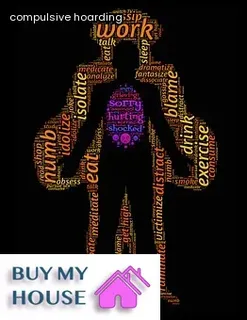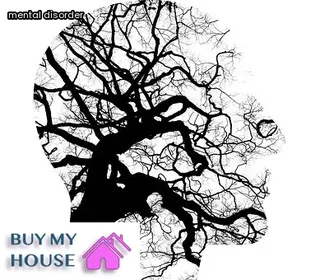Hoarding disorder is a complex mental health condition that affects an individual’s ability to properly organize and manage their possessions. It can range from mild to severe, with more extreme cases causing significant distress and disruption to daily life.
The five stages of house hoarding involve collecting items, difficulty discarding objects, excessive clutter, hiding items, and compulsive buying. Identifying the signs of hoarding disorder is key to getting help for the individual affected as early intervention can be beneficial in preventing further deterioration of the home environment and quality of life.
Hoarders can often become overwhelmed by their own possessions leading to depression or social isolation due to embarrassment or fear of judgement from family or friends. Professional treatment options include cognitive behavior therapy which focuses on developing healthier ways of thinking about possessions as well as organizational skills training and medication management for co-occurring mental illnesses such as anxiety or depression.
With the right support and treatment plan, it is possible for hoarders to gain control over their lives and surroundings.

Hoarding disorder is a serious mental health condition that affects an estimated 2-6% of the population. It is characterized by the compulsive need to acquire and save items, often of little or no value, leading to cluttered and dangerous living conditions.
Although the causes of hoarding are not fully understood, it is believed to be linked to both genetic and environmental factors. Behavioral traits associated with hoarding include avoidance of decision-making, perfectionism, impulsivity, and difficulty organizing and discarding items.
In severe cases, hoarders may not only fill their homes with possessions but also cause significant disruption to their daily lives due to financial issues or difficulty functioning in other areas such as work or family relationships. Hoarders can develop physical and psychological problems related to the stress caused by clutter and poor hygiene.
They can also experience social isolation when friends or family fear entering their home due to safety concerns. Hoarding can also create a risk of fire from electrical hazards caused by overloaded outlets or blocked exits from piles of stuff.
It’s important for those suffering from hoarding disorder to seek professional help in order to address the underlying causes of their behavior and avoid potentially dangerous consequences.
Hoarding disorder can be a difficult condition to identify and manage, but understanding the symptoms of severe hoarding is an important first step in seeking help. People suffering from this mental health problem may experience significant distress when trying to discard items, even if they are of no real value.
They may feel guilty or ashamed if someone tries to remove the objects from their home, and may become agitated or angry if they believe their possessions are being threatened. Hoarders also tend to acquire large amounts of items that can take up much of their living space.
These include not just useful items but also things like rubbish, magazines and newspapers which are kept for fear that throwing them away would lead to some sort of loss or regret. Other signs of hoarding disorder include disorganised living areas with piles of clutter, difficulty making decisions about what to keep and what to throw away, and a risk of fire hazards due to blocked exits and pathways.

Hoarding disorder can have a detrimental impact on both the individuals affected as well as those around them. Hoarding is a multi-faceted issue that can cause physical and mental health problems, financial issues, and even social isolation.
It is important to understand the five stages of house hoarding in order to identify it and get help for those affected. The first stage is the accumulation phase, which involves collecting items that may not be necessary or useful.
In the second stage, the individual experiences difficulty discarding items due to emotional attachments or feelings of guilt. The third stage is when clutter begins to accumulate in an organized way, with piles being created in specific areas of the home.
The fourth stage involves disorganization and chaos as more items are added and no longer fit in their designated area. Finally, in the fifth stage there is extreme disarray due to hazardous conditions caused by hoarding behaviors.
Recognizing these stages can be a first step towards getting help for someone who may be struggling with hoarding disorder. It is essential to seek professional consultation in order to create an effective treatment plan that addresses both physical and psychological aspects of hoarding disorder.
Hoarding disorder is a serious and often debilitating mental health condition that can affect individuals from all walks of life. If you or someone you know has been exhibiting signs of hoarding, it’s important to understand the five stages of house hoarding—accumulation, cluttering, squalor, disorganization, and severe disorganization—and to recognize when it’s time to seek professional help.
While overcoming hoarding disorder is a long and difficult process, there are strategies that can help those affected start the journey towards recovery. One of the most effective ways to tackle hoarding is with cognitive behavioural therapy (CBT), which helps individuals identify unhelpful thought patterns and behaviours that contribute to their hoarding behaviour.
Therapy sessions also focus on developing skills for regulating emotions and dealing with anxiety associated with decluttering processes. Other helpful strategies include increasing social support by joining local support groups, setting realistic goals for clearing out items in the home, enlisting professional cleaning services to help address safety issues within the home environment, and creating an action plan that outlines steps to manage clutter as it accumulates over time.
Regardless of where an individual is on their journey towards recovery from hoarding disorder, these strategies can provide valuable insights into how to begin building a healthier lifestyle free from compulsive hoarding.

When it comes to hoarding, the severity of the disorder can vary from person to person. It is important for family and friends to be able to identify different levels of hoarding in order to provide support and help.
The most severe form of hoarding is classified as ‘Disorderly Hoarding’, which is defined by excessive clutter and difficulty discarding items. It is usually accompanied by significant distress or impairment in functioning.
Moving down the scale, ‘Compulsive Hoarding’ includes a compulsive need to acquire items that are not necessary or useful and difficulty organizing them into categories. This level also includes an emotional attachment with items that make it hard for the individual to part with them.
A third level is ‘Collecting Hoarding’, where individuals compulsively acquire objects but are often able to organize them into categories. Lastly, at the lowest level of hoarding is ‘Occasional Cluttering’ which includes an inability to keep up with cleaning and organizing on a daily basis due to time constraints or other difficulties.
Understanding these levels can help families better understand how best to support their loved one who may be struggling with the disorder and get them proper help if needed.
Compulsive hoarding is a complex disorder that requires specialized treatment. It is important to seek professional help from a medical doctor or psychologist who can evaluate the severity of the hoarding.
Medication may be used to treat underlying mental health conditions such as depression, anxiety and obsessive-compulsive disorder (OCD). Cognitive behavioral therapy (CBT) can help identify unhealthy patterns of thought and behavior and provide coping strategies to reduce compulsive hoarding.
In cases where hoarding has caused extreme distress or interfered with daily activities, exposure therapy may be used to gradually desensitize the individual to triggers that cause them to hoard. Family therapy can also be beneficial, helping family members better understand the condition and providing support for loved ones who are affected by it.
Finally, social skills training can help people develop more effective communication skills and foster healthy relationships in their lives. With all these treatment options available, individuals with compulsive hoarding can begin to make progress towards recovery.

When families are dealing with a hoarder, they may feel overwhelmed, helpless, and isolated. It is important to know that help is available and there are resources to assist in the process of addressing hoarding disorder.
Professional counselors and therapists can provide support to both the hoarder and the family. Clutter clearing specialists can assist in developing strategies to help organize and declutter the home while maintaining respect for the hoarder's possessions.
Support groups can also be beneficial as they provide an opportunity for families to connect with others who have similar experiences. Other organizations are devoted to helping people with hoarding issues by providing education, advocacy, research and training programs for caregivers.
Lastly, local government health departments may offer assistance in finding resources such as housing options, financial aid or mental health services.
Cognitive Behavioral Therapy (CBT) is a type of psychotherapy that focuses on challenging and changing unhelpful thoughts, feelings and behaviors. It is often used to help people with hoarding disorder by teaching them how to identify triggers that lead to hoarding behaviors, challenge their irrational beliefs about possessions, and develop strategies to discard items they no longer need.
Through CBT, individuals can also learn how to break down tasks into manageable steps, set goals for their environment, practice mindful behaviors such as meditation, and work on skills such as decision making and problem solving. By improving these skills and addressing underlying issues that may have caused the hoarding behavior in the first place, individuals can gain control over their urges to accumulate possessions.
Ultimately, by understanding the cognitive aspects of hoarding disorder, individuals who struggle with this condition can more effectively address their behavior and get back on track toward a healthier lifestyle.

When it comes to hoarding disorder, professional help is necessary when the individual has difficulty managing the clutter and their home environment is becoming dangerous. Hoarding can become a serious issue if it is left untreated, leading to health risks such as an increased risk of falls and fires.
Hoarders may not recognize how out-of-control their behavior has become, and that’s why it’s important for family members or friends to identify the signs of hoarding and reach out for help. Professional assistance should be sought when there are numerous piles of belongings blocking access to rooms or pathways, when expired foods are being stored in the refrigerator or cabinets, when animals are being kept in unsanitary conditions, or when infestations of rodents and insects are present.
When these issues are present, it’s important to seek out a qualified mental health professional who specializes in treating hoarding disorder so they can work with the individual to develop strategies that will help them manage their symptoms and develop healthier habits.
Hoarding behavior is a serious condition that can be difficult to manage without help.
Many people who have hoarding disorder are ashamed of their behavior and try to hide it from others, making it even more difficult to get the help they need.
But with the right kind of support and understanding, it is possible for those affected by hoarding disorder to learn how to cope with their symptoms.
Coping mechanisms for managing hoarding behaviour can include cognitive behavioural therapy, mindfulness techniques, motivating oneself through rewards and activities that bring joy, identifying triggers and developing strategies for avoiding them, having a supportive network of family or friends who understand and offer unconditional acceptance, setting realistic goals for reducing clutter and gradually working towards them, learning healthy ways to deal with stress and anxiety, being open-minded about seeking out professional help when needed, and taking small steps each day towards overcoming hoarding disorder.

Eye movement desensitization and reprocessing (EMDR) psychology is an evidence-based therapy used to treat a variety of mental health issues, including hoarding disorder. EMDR is a type of psychotherapy that uses bilateral stimulation—such as eye movements, sounds, or tactile sensations—to access and process traumatic memories in order to reduce their negative impact.
This approach can help individuals with hoarding disorder become more aware of their behavior and the underlying cause of their distress. During treatment, the therapist will guide the patient through identifying triggers associated with the hoarding behavior, such as feelings of guilt or shame, and replacing those memories with new, positive thoughts.
Through this process, patients can learn to recognize when they are at risk for compulsive hoarding behaviors and use cognitive strategies to manage them more effectively. By addressing the root causes of hoarding disorder from a therapeutic standpoint, EMDR psychology can be an effective tool for helping individuals identify and overcome the five stages of house hoarding: denial, collecting/organizing clutter, acquiring items beyond capacity, isolating oneself from friends and family members due to embarrassment about living conditions, and finally feeling overwhelmed by excessive possessions.
Obsessive Compulsive Disorder (OCD) and Hoarding Disorder are closely related mental health conditions, with individuals suffering from OCD more likely to develop hoarding behaviors. In fact, the two disorders share similar characteristics including difficulty discarding items, preoccupation with collecting items, difficulty organizing possessions, and excessive acquisition.
Additionally, hoarding behavior is often associated with other mental health issues such as depression and anxiety. It’s important to understand the relationship between OCD and hoarding disorder in order to effectively identify and treat both conditions.
To do this, it’s important to recognize the five stages of house hoarding: denial, resistance, chaos, crisis management and recovery. These stages can provide guidance on how to help someone struggling with hoarding disorder by allowing them to recognize red flags that indicate a need for professional help or support groups in the community.
Understanding the connection between OCD and hoarding can make a huge difference in helping those suffering from both conditions get the assistance they need.

Hoarding disorder is a serious mental health condition that can have a profound impact on the lives of those it affects. Understanding the role of environment in developing a hoarder's mindset is essential to providing effective help and support.
Typically, hoarding behavior develops gradually over time and has five distinct stages: acquisition, cluttering, disorganization, distress, and finally eviction or death. In the early stages of hoarding, individuals may acquire more than they need due to a lack of control or impulse buying.
As the condition progresses, clutter begins to take up significant space in their home and the affected individual may experience severe distress when asked to discard items. Disorganization follows as piles of items accumulate in every room and corridors become blocked off.
If left untreated, hoarding can lead to eviction or even death due to an inability to live safely within one's home. It is important for healthcare providers, family members, and friends to be aware of the environmental factors that contribute to hoarding behavior so that appropriate interventions can be put in place.
These interventions may include cognitive behavioral therapy (CBT), medication management, decluttering assistance from professional organizers or therapists who specialize in hoarding disorder treatment, as well as social support and education about managing possessions responsibly.
Support groups can be a valuable resource for those suffering from compulsive hoarding disorder. Hoarders may find that talking to others who understand their struggles and have gone through similar experiences is a great way to gain insight into the condition and receive support in managing it.
In addition, simply having someone to talk to who is non-judgmental and understanding can be beneficial in helping hoarders start the process of overcoming their disorder. Support groups are also an important part of the 5 stages of house hoarding: identifying the problem, taking steps to clean out spaces, organizing, maintaining, and seeking professional help.
During each stage, support groups are there to provide guidance and motivation as well as offer emotional support when needed. Furthermore, these groups often meet regularly which gives hoarders an opportunity to develop relationships with other members and build meaningful bonds that may help reduce feelings of isolation associated with hoarding disorder.
Level 1 hoarding is the least severe form of hoarding disorder and typically looks like an excessive accumulation of possessions. These items may range from papers, books, magazines and newspapers to clothing, furniture, and other miscellaneous objects.
Hoarders at this level of the disorder often find it difficult to throw away or donate items even if they are no longer useful or needed. Level 1 hoarders will usually be able to keep their living space relatively organized and clutter-free, but still feel overwhelmed by the amount of stuff in their homes.
It is important for those affected by hoarding disorder to get help as soon as possible so that it does not progress into more dangerous levels. Professional help such as therapy with a mental health professional can be extremely beneficial in helping individuals manage their symptoms and live a happier life.

A Category 5 hoarder is the highest level of house hoarding, and it is characterized by extreme accumulation of items to the point of filling an entire room or home with clutter. These individuals may have difficulty discarding possessions and may even collect items that are considered hazardous or unhealthy.
Common signs of a Category 5 hoarder include having a home filled with trash, blocked off areas, and not being able to use furniture or appliances because they are blocked by clutter. Hoarding can also cause health issues due to the presence of dust, mold, insects, and other contaminants that can accumulate in a cluttered environment.
It is important for those struggling with hoarding disorder to seek professional help in order to identify potential triggers and develop strategies for managing their symptoms. With proper support and treatment, Category 5 hoarders can learn how to safely reduce clutter in their homes and regain control over their lives.
Hoarding is a disorder that can be deeply rooted in the individual's psyche. It can stem from a variety of causes, including anxiety, depression, past trauma, or loneliness.
Those who hoard may not even be aware of why they do it. In some cases, they may have collected items since childhood and believe them to be necessary for survival or to bring comfort.
In other cases, hoarding may develop as an attempt to fill an emotional void or cope with difficult life experiences. Hoarders often struggle with difficulty making decisions and organizing their environment due to feelings of guilt or fear of loss.
They also tend to experience feelings of shame and inadequacy related to their disorder. As such, understanding the root cause of hoarding is key in order to identify and get help for hoarding disorder.
Level 4 hoarding is a severe form of hoarding disorder and is the most difficult stage of house hoarding to overcome. It involves a large amount of clutter that has spilled over into multiple rooms, making it increasingly difficult to access furniture or appliances.
The individual may also experience health and safety risks due to hazardous materials or extreme clutter. Level 4 hoarders often have difficulty discarding items even if they are no longer useful, leading to an inability to use living spaces for their intended purpose.
Signs of level 4 hoarding include an overwhelming amount of possessions, difficulty accessing doorways or windows, blocked entrances, holes in walls and ceilings from structural damage, mold and mildew growth due to lack of ventilation, pest infestations, rotting food in refrigerators, and clogged toilets. It is important for those suffering from level 4 hoarding disorder to seek help from professionals who can provide the necessary support and resources needed to help manage the condition.
A: House hoarding is a mental health disorder, often associated with anxiety disorder and other psychiatric issues. The five stages of house hoarding include acquiring items, difficulty discarding items, cluttering living spaces, distress and/or impairment in functioning due to clutter, and loss of control over acquisition of items. Each stage can have an impact on a person's mental health, increasing their risk for depression, anxiety, and other psychiatric disorders.